December 11, 2019 report
ISS sensors show terrestrial gamma-ray flash and ionospheric UV emissions spurred by lightning

A team of researchers from Denmark, Norway, Spain and Italy has found that both terrestrial gamma-ray flashes and ionospheric ultraviolet emissions are spurred by lightning. In their paper published in the journal Science, the group describes their study of data from the Atmosphere-Space Interactions Monitor (ASIM) aboard the International Space Station (ISS), and what they found.
Prior research has shown that terrestrial gamma-ray flashes (TGFs) are created by thunderstorms. So, too, are ultraviolet and optical emissions (elves) found in the lower ionosphere during thunderstorms. But the process involved in the creation of each has not been clear. Prior research had shown that elves are set off by an electromagnetic pulse emanating from a bolt of lightning in a thunderstorm. It has not been clear what sets off TGFs.
To learn more about both types of flashes and how they may be related to lightning bolts, the researchers studied data from the ASIM, which is affixed to the exterior of the ISS. The device is able to capture X-ray and gamma-ray data coming from thunderstorms. It also has cameras that can capture images and data in both visible and ultraviolet light.
The researchers chose a time period during which a thunderstorm was occurring just below the device. It captured information about lightning flashes, TGFs and Elves. In looking at the data, the researchers were able to see that a TGF was produced by a field of electricity just before a lightning bolt appeared in the same cloud. They were also able to see that the same bolt of lightning unleashed an electromagnet pulse, which pushed an elve into existence above the thunderstorm. Thus, both types of flashes were found to be spurred into existence by bolts of lightning. They also noted that elve formation occurred when lightning struck something on the ground, and that event, the researchers suggest, led to changes in the lightning bolt, which somehow triggered the elve. But they also noted that in other instances, an elve could come into existence without lightning striking the ground, suggesting that there is still more to learn about their nature.
More information: A terrestrial gamma-ray flash and ionospheric ultraviolet emissions powered by lightning, Science 10 Dec 2019: eaax3872, DOI: 10.1126/science.aax3872 , science.sciencemag.org/content … 2/09/science.aax3872
Journal information: Science
© 2019 Science X Network


















